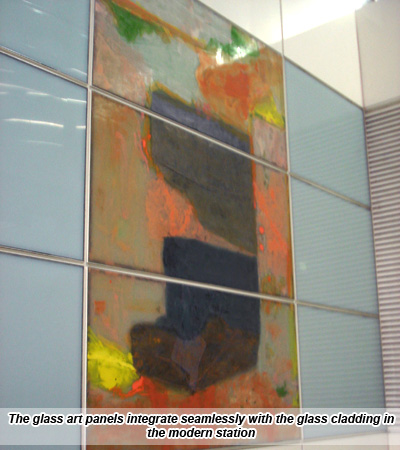|

Punggol station

The northern-most station
along the North East Line, Punggol station has the
distinction of being the line's longest station, stretching
for 320 metres. One of only two
stations on the line built above ground, the futuristic
Punggol station is a spectacular sight with its
three-dimensional curved aluminium and stainless steel
cladding.
The station also has the most lifts among the stations on
the North East Line; a total of six lifts among the stations
on the North East Line serve this massive
facility.
One unique feature of
Punggol station is that Punggol Central Road runs through it
at ground level, creating a stunning visual effect. The
station has also been
designed to integrate with the future LRT station and bus
interchange.
Back To Top
Goh Beng Kwan's insistence
on capturing the moment comes through in the fabulous
colours and fascinating textures of the semi-abstract paper
collages that are his
signature works.
The same vitality comes
across vividly in his works at Punggol station crafted
around the themes of water, landscape and the future.
Working in glass for the
first time in his career, the artist has created nine panels
for Punggol station. Being displayed in gallery-style around
the concourse, the 3
metres by 2 metres panels catch the natural light in the
station.

Back To Top
The artist's mastery of
colours, the delicate layering of glass and the sheer
simplicity of his concept are also rooted in his warm
memories of Punggol.
As a boy scout, Beng Kwan
remembers camping by the beach, under the stars. All these
memories of Punggol's past are captured in the artist's use
of colour in his
works; blue and turquoise for the ocean, yellow, brown and
sienna for the kampung and green for the
trees.

In conceptualising his
work, the artist first created nine paintings in oil and
acrylic on canvas. He then had a three dimensional model of
the station made and put up
computer-generated copies of his works on the model.
Working in glass also
stretched the artist's creative frontiers. Goh Beng Kwan has
been known to experiment widely with materials like paper,
metal, silk, plywood
and plastic. However, glass forced the artist to adjust to a
different creative tempo altogether.
Back To Top

While artworks in glass
are often back-lit for effect, the nature-lover in Beng Kwan
takes pride in the fact that no special lighting will be
used for his works at
Punggol.
The artist hopes the
languid, leisurely mood of his works will rub off on
commuters as they journey to and from work. But more than
just good vibes, the artist hopes
that for senior citizens who can't read, they can tell
they're at Punggol station by recognising the colours in his
works. For all other commuters, he hopes they would
immerse themselves in his artworks and let his feeling of
Punggol flow through.
Artist:
Goh Beng Kwan
Born: Indonesia, 1937
Education:
- Studied with Singapore artist Chen Wen His, 1952 - 1961
- Art Student League of New York with Sydney Gross, 1962
New York, USA
- Provincetown Workshop, 1964
Massachusetts, USA
next: Advertising
Back To Top
|